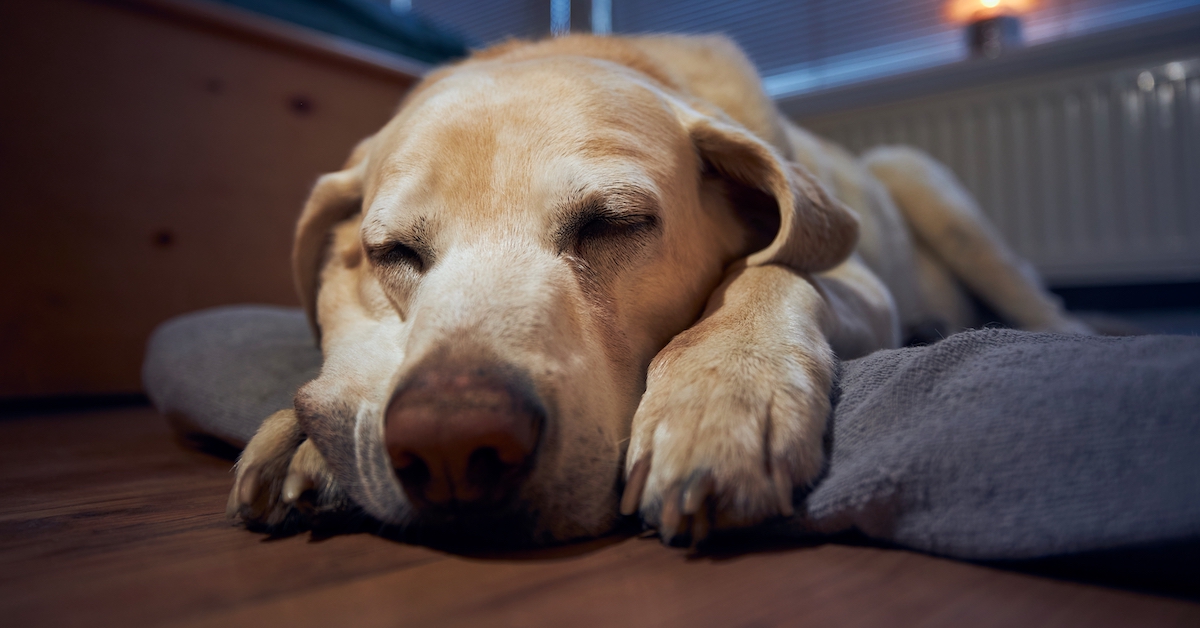Does My Elderly Dog Need an Orthopedic Bed?
Orthopedic beds can provide senior dogs with extra support and evenly distribute their weight to relieve pressure points.

Aging affects dogs in much the same way it affects humans. Dogs will start to slow down, possibly put on weight, become weaker, and more vulnerable to infections. Many canines experience vision and hearing changes, as well as a loss of mobility. While evidence of decline is usually more subtle in smaller dogs, even the tiniest chihuahua is not immune to the effects of aging.
While there is no way to stop the aging process, you can take essential steps to make your pet more comfortable. Senior dogs require extra special care to help ease stress on their tired joints and muscles. One way to help diminish discomfort and ward off stiffness is to purchase an orthopedic bed for your pet. Learn more about orthopedic dog beds, their key advantages, and whether you should get one for your elderly dog.
What Is an Orthopedic Dog Bed?
Orthopedic dog beds are becoming increasingly common across the U.S. These innovative beds provide the extra support your senior dog needs to relieve pressure around the joints and muscles. Most orthopedic dog beds are constructed of memory foam but can also contain other materials as long as the mattress is durable, thick, and provides adequate support. When a dog lies down on an orthopedic bed, he should not feel the floor through the mattress.
Many traditional dog beds on the market contain cotton filling, polyester filling, or cedar chips. These beds are typically less expensive but also provide less support. The filling in non-orthopedic dog beds can flatten or separate over time, providing your dog with little support and comfort. While these types of beds are generally okay for younger dogs, elderly dogs tend to need the extra plush and padding only available with modern orthopedic dog beds.
What are the Benefits of Orthopedic Beds?
An orthopedic dog bed can be a worthwhile investment if you have an injured, ill, or elderly dog. Many pet owners with young, healthy dogs also choose orthopedic beds to ensure that their pup is as comfortable as possible. Here are some of the key benefits of choosing an orthopedic dog bed:
- A cozy place to nap. An orthopedic bed provides your senior pet with a soft and comfortable place to nap. It’s a far better alternative to sleeping on the floor and is often easier for pets to climb onto compared to sofas and human beds.
- Improved quality of sleep. You can expect your senior dog to have a better quality of sleep when you choose an orthopedic bed compared to an inferior option. If your senior dog has hip dysplasia, arthritis, or simply worn-out muscles and joints, an orthopedic bed can provide the comfort your aging dog needs.
- Preventative canine care. Preventative care for dogs means more than just bringing your pet for regular checkups. Making small improvements at home, such as switching to an orthopedic bed, can help prevent future problems by distributing your pet’s weight and warding off muscle and joint pain.
- Easy to clean. Most orthopedic dog beds contain outer coverings that can be easily removed and thrown in the wash. Whether your dog has muddy paws or has an accident, you can rest assured that the cleaning process is simple.
- Support health conditions. Orthopedic dog beds are great for supporting a wide range of health conditions, ranging from painful arthritis and hip dysplasia to chronic joint and muscle problems.
Does Your Dog Need an Orthopedic Bed?
Not sure if your dog really needs an orthopedic bed? Ask yourself a few simple questions. First, does your dog have a hard time getting in and out of their regular dog bed? If so, it could be because the bed is not providing adequate support, causing your dog to experience some stiffness and discomfort. You may also notice that your dog appears stiff and slow-moving after getting up from their regular dog bed.
Another sign that you may need to upgrade to an orthopedic dog bed is if your dog seems to constantly change positions. Whether your dog is just taking a nap or sleeps in the dog bed, you may notice that he can’t get comfortable. In some cases, a dog may refuse to sleep in his bed at all. You should also consider an orthopedic bed if your dog suffers from joint problems, arthritis, hip dysplasia, or bone or soft tissue injuries.
What Features Should I Look for in a Bed?
While orthopedic beds are designed to support injured or aging dogs, they are not all made equal. There are several features that you’ll want to consider when shopping for an orthopedic bed, starting with the right materials.
Avoid low-quality materials, such as beds made from high-memory fiber fill, egg crate foam, medical-grade hospital foam, batting, polyester fiber, or recycled fiber. Instead, opt for a bed made of quality memory foam with a minimum depth of two inches.
Also, consider the style of the bed. Many orthopedic beds will feature a “bolster” that runs along the back and sides to help elevate the head. If your dog likes to burrow, a “nesting” bed features a hood that creates a tent-like atmosphere. You’ll also want to consider the size of the bed. Choose a bed that offers your pet enough space to spread out without limbs hanging over the edge.
Orthopedic pet beds can be pricey so you’ll want to do plenty of research before making a decision. With the right bed, your dog can live out his senior years comfortably and content.
Ready to start saving money on pet wellness care?
Then take a look at Mint Wellness, the pet wellness plan that provides fast reimbursement on routine pet care. Save on vaccinations, wellness exams, preventatives, dental, and more!
Learn More


